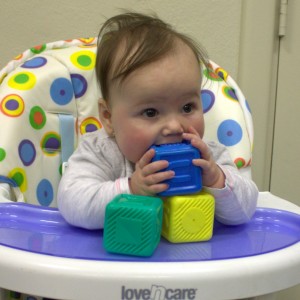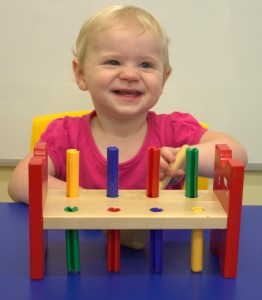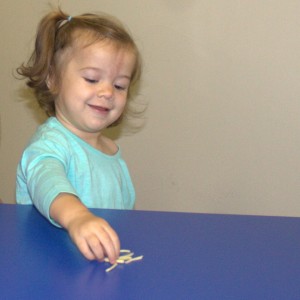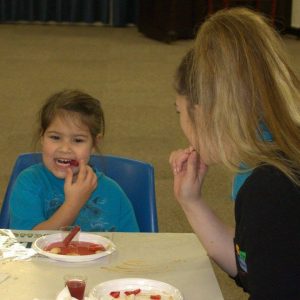 Learning to eat is a complex process and children develop the skills they need gradually over time. Below is a list of the skills children develop at different ages and some ideas for helping children learn these skills. Children with developmental, learning, motor or sensory issues may take longer to develop these skills. Children will progress at their own pace and should not be pushed to try tasks or foods if they do not feel confident and comfortable.
Learning to eat is a complex process and children develop the skills they need gradually over time. Below is a list of the skills children develop at different ages and some ideas for helping children learn these skills. Children with developmental, learning, motor or sensory issues may take longer to develop these skills. Children will progress at their own pace and should not be pushed to try tasks or foods if they do not feel confident and comfortable.
Feeding development begins before birth as in the last 6 to 8 weeks of pregnancy the baby learns to coordinate the suck, swallow then breathe pattern they will use for breast or bottle feeding after birth.
Strategies for this stage:
- Breastfeed if possible. One of the many advantages of breast feeding is that it exposes the baby to different tastes and smells as breast milk changes with the foods the mother eats. These variations in the milk help babies to tolerate different flavours of foods later on.
 Between two and four months of age babies learn to control the head movements. They also move from an automatic sucking to an active sucking movement with voluntary control. Jaw growth allows more space in the mouth for the tongue to move forward and back and this also helps develop a more mature sucking pattern.
Between two and four months of age babies learn to control the head movements. They also move from an automatic sucking to an active sucking movement with voluntary control. Jaw growth allows more space in the mouth for the tongue to move forward and back and this also helps develop a more mature sucking pattern.
- Allow exploration of fingers and safe toys with the mouth. Babies at this age begin to put their hands and toys in their mouths as this is important for the development of the movement patterns and sensory skills needed for eating. It helps develop tongue movements and eye hand mouth coordination as well as reducing sensory sensitivity. Young babies will gag in response to things at the front of the mouth as a protective reaction, but this needs to reduce in order to eat solid food. Mouthing objects helps move the gag reflex to move further back in the mouth.
Older babies from around six months develop the ability to sit upright and hold their head still.
- As babies begin to take smooth pureed foods offer a range of tastes and smooth textures. Some foods to try include: pureed fruits and vegetables, mashed banana or avocado, smooth thick soups, smooth hummus, porridge, polenta, weetbix mashed in milk, milk based desserts, smooth yoghurt.
- Allow babies to experiment with solid foods they can hold and munch on but not bite off. Supervise them closely and if they bite off any pieces remove the food. Long stick shaped foods that they can hold and move around their mouth help develop oral movements and sensory skills. These can include: rusks, strips of toast, sticks of hard raw vegetables such as carrots, celery and parsnip, strips of dried mango or pineapple.
 Between seven and nine months babies learn to move their tongues from side to side, rather than just back and forward. They learn to close their lips so that food is taken from a spoon more easily and moved to the back of the mouth for swallowing. They begin to be able to munch with an up down jaw movement.
Between seven and nine months babies learn to move their tongues from side to side, rather than just back and forward. They learn to close their lips so that food is taken from a spoon more easily and moved to the back of the mouth for swallowing. They begin to be able to munch with an up down jaw movement.
- When your baby is sitting up well and managing soft, smooth foods from a spoon gradually introduce soft lumps into spooned foods. You can do this by mashing food with a fork and gradually making the texture more solid and uneven as your baby progresses. You can also introduce foods such as scrambled eggs, soups with soft lumps and mashed well cooked pieces of casseroles.
- When your baby is managing lumpy soft foods and making munching movements you can introduce soft solids they can eat with their fingers such as cubes of soft cooked vegetables or soft fruits, strips of soft bread with spreads and no crusts and foods that dissolve in their mouth such as arrowroot biscuits and softer, flaky crackers.
From around one year of age children learn to move their jaw in a sideways and a circular pattern for more effective chewing. They also develop more control over their side to side tongue movements which helps keep food between the back teeth when chewing. Children's taste buds also mature at this age and children may become more discerning of different flavours. By around 14 months children are quite efficient at eating finger foods and begin to explore using spoons and forks. To introduce cutlery to your child:
- Use small child sized cutlery initially.
- Allow your child to hold a spoon and attempt to feed themselves as you feed them with spoon foods. Gradually allow them to do more all by themselves.
- Stab small cubes of food onto a fork and help your child guide it into their mouth initially. Once then can get it into their mouth help them to stab the food onto the fork.
 By 18 months most children have the oral skills to manage any foods presented but it will take until around two years of age to master eating efficiently with cutlery and even after this age they may still need some help to cut foods up.
By 18 months most children have the oral skills to manage any foods presented but it will take until around two years of age to master eating efficiently with cutlery and even after this age they may still need some help to cut foods up.
- At this age children can be offered the same foods as the rest of the family, though it may need to be cut into smaller pieces for them.
- Toddlers and preschooler often go through a fussy stage where they are reluctant to try new foods. This is normal but children will be more willing to try foods they have seen many times and foods they have seen parents eating. Offering variety from any early age can help.
- Children may be more willing to try foods from a parents plate than their own. This is a protective instinct and can be used to help introduce new foods.
What if my child's eating is not developing as expected?
 Some children need professional help to develop good eating. Often this is because they have difficulty developing the motor skills or sensory skills needed for eating. Some signs a child needs extra help include:
Some children need professional help to develop good eating. Often this is because they have difficulty developing the motor skills or sensory skills needed for eating. Some signs a child needs extra help include:
- Not eating puree or baby food by ten months
- Not eating table foods by 12 months
- Not drinking from a cup by 16 months
- Not eating anything other than baby food or puree by 16 months
- Coughing, vomitting or choking during meals or when drinking
- Eating less than 20 foods and dropping off foods that were previously eaten
- Avoiding all foods in a certain texture or food group
- Parents and or child find mealtimes consistently stressful or a battle.
Talking Matters team members have done training in SOS (Sensory Oral Sequential) feeding and can assess children and support the development of eating skills. To find out more about SOS feeding visit their website. Talking Matters have Food School group programs for fussy eaters these school holidays based on the SOS approach to feeding.
Talking Matters provides speech pathology, occupational therapy and psychology. We have a range of service options including individual therapy in our office at bright, child friendly clinic in Elizabeth Downs as well as many school based services. We also do group programs and home or child care visits by negotiation.
Whether you live locally and can come in and see us, or are further afield and want to make use of our extensive range of free resources, we look forward to sharing our passion for helping kids learn and develop. browse our website or call us on (08) 8255 7137 to find out more about what we can offer you.
For more ideas and resources for developing children's speech, language, learning and social skills check our extensive Pinterest page. Like us on Facebook and follow us on Twitter so you don't miss out on what's happening.
Related Blog Posts
If you liked this post you may also like:
Helping fussy and reluctant eaters
Tips for fussy eaters
Why eating can be hard!
Boost brain power!



